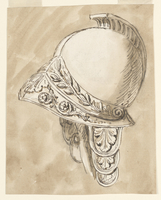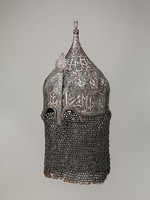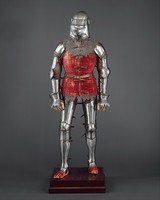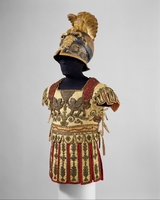Items
Tag
Helmet
-
 Helmet A pen and ink drawing of a Greek and Roman Helmet. Giuseppe Barberi captured the metalwork of the piece of armor.
Helmet A pen and ink drawing of a Greek and Roman Helmet. Giuseppe Barberi captured the metalwork of the piece of armor. -
 Helmet with Aventail This especially attractive and well preserved turban helmet retains the mail aventail that protected the lower half of the face and neck. The aventail is fixed with a lead seal stamped with the mark used in the Ottoman arsenals, an indication that this example, like the other turban helmets also in the Museum's collection (acc. nos. 04.3.209, .210, .214, .457, .462; 36.25.109), passed into Turkish possession as booty with the Ottoman conquest of Iran and the Caucasus. At least one turban helmet decorated in a style comparable to this example bears the name of Farruhk-Siar (reigned 1464–1501), ruler of Shirvan in the Caucasus. Such evidence suggests that this helmet is also of Shirvan manufacture.
Helmet with Aventail This especially attractive and well preserved turban helmet retains the mail aventail that protected the lower half of the face and neck. The aventail is fixed with a lead seal stamped with the mark used in the Ottoman arsenals, an indication that this example, like the other turban helmets also in the Museum's collection (acc. nos. 04.3.209, .210, .214, .457, .462; 36.25.109), passed into Turkish possession as booty with the Ottoman conquest of Iran and the Caucasus. At least one turban helmet decorated in a style comparable to this example bears the name of Farruhk-Siar (reigned 1464–1501), ruler of Shirvan in the Caucasus. Such evidence suggests that this helmet is also of Shirvan manufacture. -
 Armor This armor was assembled and restored under the direction of Dr. Bashford Dean in the 1920s, when it was part of his private collection. It consists of elements mostly from Chalcis, such as those exhibited in the vitrines to the left and right. Dean's intent was to present a full armor of the style worn about 1400, a period from which no complete armors survive. Distinctive features are the early form of brigandine (a torso defense constructed of plates riveted inside a doublet) and the brass borders on the edges of the exposed plates of the other parts of the armor. Portions of the brass at the top edge of the left cuisse (thigh defense), the lower edges of the right greave (lower leg defense), and the visor are genuine; the remainder of the brass is restored. The helmet, a visored bascinet, is not from Chalcis. The velvet covering of the brigandine is a restoration of the early twentieth century.
Armor This armor was assembled and restored under the direction of Dr. Bashford Dean in the 1920s, when it was part of his private collection. It consists of elements mostly from Chalcis, such as those exhibited in the vitrines to the left and right. Dean's intent was to present a full armor of the style worn about 1400, a period from which no complete armors survive. Distinctive features are the early form of brigandine (a torso defense constructed of plates riveted inside a doublet) and the brass borders on the edges of the exposed plates of the other parts of the armor. Portions of the brass at the top edge of the left cuisse (thigh defense), the lower edges of the right greave (lower leg defense), and the visor are genuine; the remainder of the brass is restored. The helmet, a visored bascinet, is not from Chalcis. The velvet covering of the brigandine is a restoration of the early twentieth century. -
 Statute Law - Helmet for Figure of "Force" A study done in preparation of a mural. At the turn of the twentieth century, American artists decorated important public buildings with colorful and theatrical murals, images that were meant to enhance architectural spaces and impart lessons of good taste and moral values. In 1898 the National Society of Mural Painters nominated Kenyon Cox and nine other members to create murals for the new state appellate court building in New York City. The space given to Cox was the most challenging: Only four feet high and thirty-five feet long, it had two smaller, angled areas at each end. He chose to paint allegorical figures symbolizing the principles of law. This study for the figure of Force shows a woman wearing a helmet and looking out with a formidable expression; it is the kind of detailed sketch Cox made of each figure before beginning the mural. (Morgan, Kenyon Cox, 1856-1919: A Life in American Art, 1994)
Statute Law - Helmet for Figure of "Force" A study done in preparation of a mural. At the turn of the twentieth century, American artists decorated important public buildings with colorful and theatrical murals, images that were meant to enhance architectural spaces and impart lessons of good taste and moral values. In 1898 the National Society of Mural Painters nominated Kenyon Cox and nine other members to create murals for the new state appellate court building in New York City. The space given to Cox was the most challenging: Only four feet high and thirty-five feet long, it had two smaller, angled areas at each end. He chose to paint allegorical figures symbolizing the principles of law. This study for the figure of Force shows a woman wearing a helmet and looking out with a formidable expression; it is the kind of detailed sketch Cox made of each figure before beginning the mural. (Morgan, Kenyon Cox, 1856-1919: A Life in American Art, 1994) -
 Costume Armor and Sword in the Classical Style This pseudoclassical armor was created to be worn at an event and not on the battlefield. Pageants in pseudoclassical dress were popular in Europe from the sixteenth through the eighteenth century. An elaborate costume of the kind displayed here may have been worn for a theatrical performance or a court festivity, such as a ball or carousel in which the theme was taken from classical mythology or history. The embroidered tunic represents an embossed bronze cuirass of the type worn by high-ranking Roman officers. The stylized Greek helmet is richly decorated with mythological and allegorical figures. Inside the helmet is the original paper label that identifies the Parisian maker as Halle dit Mercier and advertises his ability to provide helmets, shields, masks, costumes, and scenery for any occasion.
Costume Armor and Sword in the Classical Style This pseudoclassical armor was created to be worn at an event and not on the battlefield. Pageants in pseudoclassical dress were popular in Europe from the sixteenth through the eighteenth century. An elaborate costume of the kind displayed here may have been worn for a theatrical performance or a court festivity, such as a ball or carousel in which the theme was taken from classical mythology or history. The embroidered tunic represents an embossed bronze cuirass of the type worn by high-ranking Roman officers. The stylized Greek helmet is richly decorated with mythological and allegorical figures. Inside the helmet is the original paper label that identifies the Parisian maker as Halle dit Mercier and advertises his ability to provide helmets, shields, masks, costumes, and scenery for any occasion.